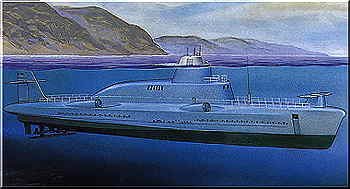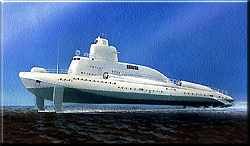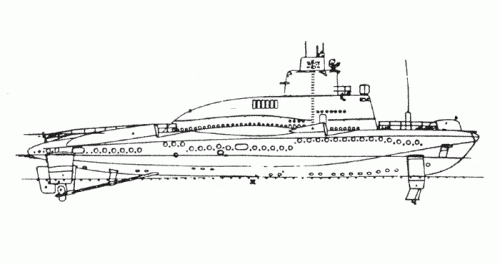Project 1231 was a program originally initiated by TsKB-19 to develop a small submersible missile boat based on an idea by Nikita Krushchev. The Project 1231 ship was tasked to deliver surprise missile attacks against hostile warships and transports in narrow passages and at approaches to enemy naval bases and ports; defend coastal areas, naval bases and sea-side flanks of land forces; repel hostile landing operations; disrupt adversary's communications, and carry out sonar and radar picketing missions in areas of scattered basing facilities of the adversary's naval forces. Presumably, a group of such ships were supposed either to deploy to the patrol area and stay underwater for a protracted period of time or make a submerged approach, maintaining a permanent sonar contact with the enemy. Upon approaching the enemy, the ships were supposed to surface, reach the missile salvo-firing line, fire the missiles, and then submerge or escape on the surface at the maximum possible speed. It was believed that the ability of the ships to stay underwater and develop high speed while attacking the enemy could reduce his time for counteraction, including air attacks.
The ship's armament would consist of four P-25 cruise missiles, derived from the P-5 Pyatyorka, "Fiver" or Grade A in English, NATO reporting name SS-N-3, with a range of 40-km arranged in separate fixed-mounted uncushioned container-launchers installed at a certain permanent angle to the horizon and remotely controlled from a common control console located in the ship's main control room. The launchers were arranged outside the pressure hull and were sealed to withstand the pressure at the maximum attainable underwater depth.
The Rangout-1231 radar, in production at that time, could detect a target at a distance of 25 to 28 km and determine its coordinates. With the ship submerged and motionless, the Kharius sonar could detect hostile ships at a distance of 60 to 120 km. The ship did not have any close-in defense weapons.
To provide for high surface speed, a foil-borne propulsion concept was accepted early in the design stage.
This project played a key role in the unification of design efforts of TsKB-19 and TsKB-5 and their subsequent merger into a single bureau, later called Almaz. Following the merger of these bureaus, Yevgeny Yukhnin, head of TsKB-5, was appointed chief designer of Project 1231.
The project was abandoned in 1964 when Nikita Krushchev was ousted from power.
Source:
"Diving Missile Boats" by Eduard Aframeev, Senior Researcher of the Krylov Central Research Institute, Military Parade
http://milparade.udm.ru/security/27/090x.htm
Artist's impression and line drawing of non-hydrofoil version and artist's impression and line drawing of two foil hydrofoil version.
The ship's armament would consist of four P-25 cruise missiles, derived from the P-5 Pyatyorka, "Fiver" or Grade A in English, NATO reporting name SS-N-3, with a range of 40-km arranged in separate fixed-mounted uncushioned container-launchers installed at a certain permanent angle to the horizon and remotely controlled from a common control console located in the ship's main control room. The launchers were arranged outside the pressure hull and were sealed to withstand the pressure at the maximum attainable underwater depth.
The Rangout-1231 radar, in production at that time, could detect a target at a distance of 25 to 28 km and determine its coordinates. With the ship submerged and motionless, the Kharius sonar could detect hostile ships at a distance of 60 to 120 km. The ship did not have any close-in defense weapons.
To provide for high surface speed, a foil-borne propulsion concept was accepted early in the design stage.
This project played a key role in the unification of design efforts of TsKB-19 and TsKB-5 and their subsequent merger into a single bureau, later called Almaz. Following the merger of these bureaus, Yevgeny Yukhnin, head of TsKB-5, was appointed chief designer of Project 1231.
The project was abandoned in 1964 when Nikita Krushchev was ousted from power.
Source:
"Diving Missile Boats" by Eduard Aframeev, Senior Researcher of the Krylov Central Research Institute, Military Parade
http://milparade.udm.ru/security/27/090x.htm
Artist's impression and line drawing of non-hydrofoil version and artist's impression and line drawing of two foil hydrofoil version.





